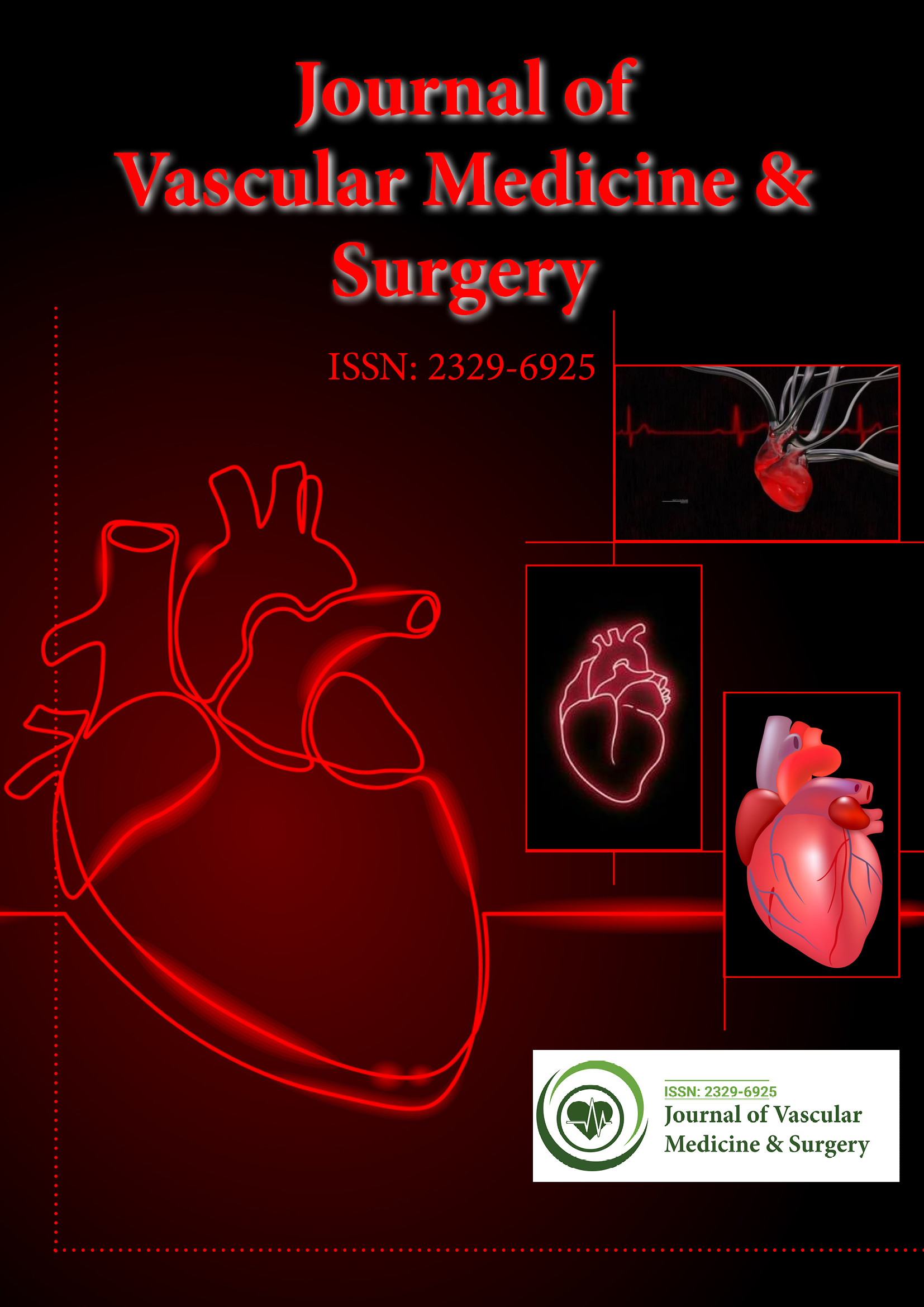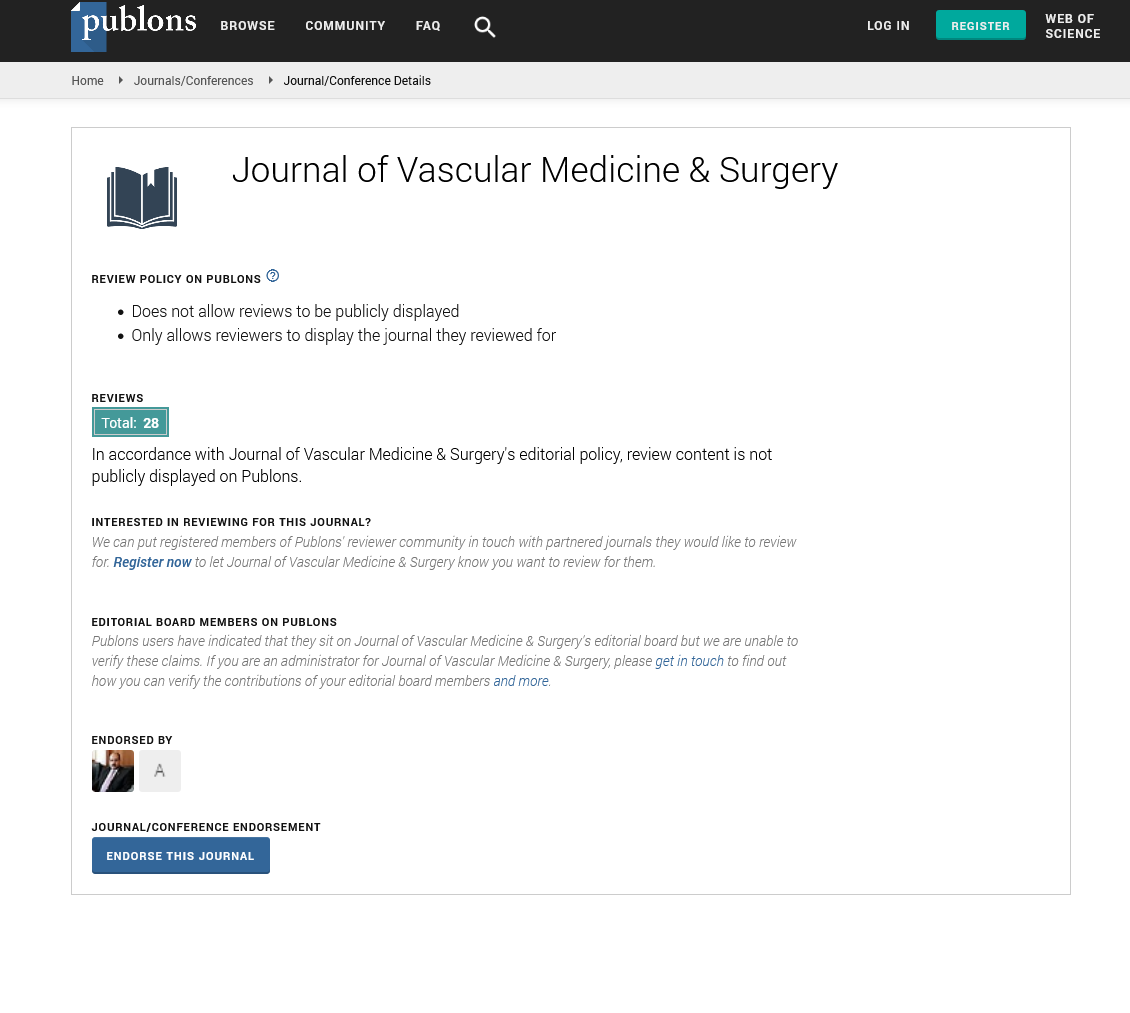Indexed In
- Open J Gate
- Academic Keys
- RefSeek
- Hamdard University
- EBSCO A-Z
- OCLC- WorldCat
- Publons
- Euro Pub
- Google Scholar
- SHERPA ROMEO
Useful Links
Share This Page
Journal Flyer

Open Access Journals
- Agri and Aquaculture
- Biochemistry
- Bioinformatics & Systems Biology
- Business & Management
- Chemistry
- Clinical Sciences
- Engineering
- Food & Nutrition
- General Science
- Genetics & Molecular Biology
- Immunology & Microbiology
- Medical Sciences
- Neuroscience & Psychology
- Nursing & Health Care
- Pharmaceutical Sciences
Mini Review - (2024) Volume 12, Issue 6
A Decade of Insights into Long-Term Outcomes of Coronary Artery Bypass Grafting using Arterial Graft: A Mini-Review
Tetsuma Oyama and Kan Kajimoto*Received: 03-Oct-2024, Manuscript No. JVMS-24-27097; Editor assigned: 07-Oct-2024, Pre QC No. JVMS-24-27097 (PQ); Reviewed: 22-Oct-2024, QC No. JVMS-24-27097; Revised: 29-Oct-2024, Manuscript No. JVMS-24-27097 (R); Published: 05-Nov-2024, DOI: 10.350310/2329-6925.24.12.571
Abstract
Coronary artery bypass grafting is a widely adopted surgical intervention for coronary artery disease and arterial graft selection significantly impacts long-term outcomes. While the Internal Thoracic Artery (ITA) is established as the gold standard for grafting the left anterior descending artery, the optimal second graft remains controversial. This mini-review critically summarizes recent findings from a study comparing ITA and Radial Artery (RA) grafts for left circumflex artery revascularization over a 10-year follow-up period. The results highlight the superiority of ITA over RA in long-term mortality, particularly after adjusting for baseline differences in patient characteristics through propensity score matching. We also review the contemporary literature and examine the potential mechanisms underlying the differential outcomes, including graft patency and risk factors such as diabetes mellitus and chronic kidney disease. The findings emphasize the need for long-term follow-up and further research to optimize graft selection, particularly in high-risk populations.
Keywords
Coronary artery bypass grafting; Internal thoracic artery; Radial artery; Long-term outcomes; Revascularization; Mortality; Graft patency
Introduction
Coronary Artery Bypass Grafting (CABG) remains a cornerstone in the treatment of complex coronary artery disease. The selection of arterial grafts has a profound impact on long-term outcomes. Due to its excellent patency rates and proven benefits in left anterior descending artery revascularization, the ITA is widely considered the optimal choice [1,2]. However, the use of a second arterial graftwhether it should be another ITA or a RA continues to be debated. Studies comparing the long-term outcomes of ITA vs. RA grafts for Left Circumflex Artery (LCx) revascularization have provided valuable insights, especially given the paucity of long-term data in Asian populations [3].
Literature Review
Long-term outcomes and graft selection
Several studies have explored the role of secondary grafts in CABG, focusing on long-term outcomes such as mortality and Major Adverse Cardiac Events (MACEs). Arterial grafts, particularly ITA, have shown superior patency compared with venous grafts, making them preferable for long-term survival and reduced adverse events [4-7]. Guidelines from the American College of Cardiology/ American Heart Association and the European Society of Cardiology favor the RA over the Saphenous Vein Graft (SVG) as a second graft [1,2]. However, the choice between a Bilateral ITA (BITA) and RA graft remains controversial.
We conducted a retrospective analysis spanning 10 years, focusing on Japanese patients who underwent LCx revascularization. We used propensity score matching to adjust for confounders and found that the BITA group had significantly lower all-cause mortality than the ITA-RA group. These findings align with previous research suggesting that arterial grafts, especially when used in situ, provide better long-term outcomes. However, most studies have been based on Western populations, with limited data available for Asian patients, making the present review especially relevant.
Risk factors and clinical implications
Diabetes Mellitus (DM) and Chronic Kidney Disease (CKD) are known to worsen outcomes post-CABG. In the present review, more patients with these conditions were in the BITA group, but still showed superior survival outcomes, suggesting that ITA may be particularly beneficial in high-risk patients. This raises important questions about graft selection in patients with DM and CKD, where the RA has been historically avoided because of concerns about forearm arteriovenous fistula requirements for hemodialysis [3]. Despite these risks, the RA is often used in younger patients or in those without significant comorbidities because of its ease of harvesting and potential for better early patency compared with SVGs [3].
Operative techniques and postoperative outcomes
Surgical techniques play a critical role in outcomes following CABG, especially when using BITA grafts. We found that skeletonized harvesting of ITA grafts and the use of negative pressure wound therapy were effective in minimizing complications such as Deep Sternal Wound Infection (DSWI), even in high-risk patients with DM. This contrasts with earlier concerns that the use of BITA might increase the risk of DSWI as a result of reduced blood flow to the sternum.
In the present review, no significant differences in secondary outcomes, such as MACE and DSWI, were found between the BITA and ITA-RA groups. This supports the safety of using BITA grafts in well-selected patients, especially with the implementation of modern wound care techniques.
Discussion
The findings of this review support the hypothesis that the ITA is a superior choice as a second arterial graft in CABG, particularly for LCx revascularization. One of the major findings was the significantly lower all-cause mortality in the BITA compared with the ITA-RA group over a 10-year follow-up period. These findings suggest that ITA grafting provides better long-term protection against cardiovascular events, even in high-risk populations.
Mechanisms behind ITA superiority
The superior outcomes associated with ITA grafts may be due to several factors. ITA is an elastic artery, and thus, more resistant to late atherosclerotic changes than muscular arteries such as the RA. This likely contributes to the higher long-term patency rates observed with ITA grafts. Moreover, when harvested using a skeletonized technique, ITA grafts can be extended to reach more distal coronary targets, improving myocardial perfusion. By contrast, RA grafts, though effective in the short to medium term, may experience higher rates of occlusion because of their muscular nature, particularly in patients with underlying vascular conditions such as DM.
Concerns regarding Deep Sternal Wound Infection (DSWI)
One of the major concerns with BITA use is the increased risk of DSWI, particularly in patients with DM. However, advances in surgical techniques, such as skeletonized harvesting of ITA and the use of negative pressure wound therapy, have mitigated this risk. The present review found no significant difference in DSWI rates between the BITA and ITA-RA groups, reinforcing the safety of BITA in appropriately selected patients. This finding is also supported by a meta-analysis that included three studies using skeletonized BITA in patients with DM [8].
Conclusion
This review adds valuable information to the ongoing debate about the optimal second arterial graft in CABG. Over a 10-year follow-up period, compared with RA, ITA demonstrated superior outcomes in all-cause mortality, particularly when used for LCx revascularization. These findings are consistent with other studies that emphasize the long-term benefits of arterial grafts over venous conduits. Given the increasing number of high-risk patients undergoing CABG, including those with DM and CKD, the use of ITA as a second graft may offer a survival advantage without increasing the risk of DSWI. Further randomized controlled trials and long-term studies in diverse populations are needed to confirm these findings and guide clinical practice.
Data Availability Statement
The data that support the findings of this review are available on request from the corresponding author.
References
- Lawton JS, Tamis-Holland JE, Bangalore S, Bates ER, Beckie TM, Bischoff JM, et al. 2021 ACC/AHA/SCAI guideline for coronary artery revascularization: Executive summary: A report of the American College of Cardiology/American Heart Association Joint Committee on Clinical Practice Guidelines. Circulation. 2022;145(3):e4–e17.
[Crossref] [Google Scholar] [PubMed]
- Neumann FJ, Sousa-Uva M, Ahlsson A, Alfonso F, Banning AP, Benedetto U, et al. 2018 ESC/EACTS Guidelines on myocardial revascularization. Eur Heart J. 2019;40(2):87-165.
[Crossref] [Google Scholar] [PubMed]
- Oda R, Kajimoto K, Yamamoto T, Endo D, Kinoshita T, Amano A, et al. Long-term outcomes of coronary artery bypass grafting using an internal thoracic artery vs. a radial artery as a second arterial graft. J Thorac Cardiovasc Surg. 2024;30(1):24-29.
[Crossref] [Google Scholar] [PubMed]
- Tsuneyoshi H, Komiya T, Shimamoto T, Sakai J, Hiraoka T, Kawashima T, et al. The second best arterial graft to the left coronary system in off-pump bypass surgery: A propensity analysis of the radial artery with proximal anastomosis to the ascending aorta vs. the right internal thoracic artery. Gen Thorac Cardiovasc Surg. 2015;63(6):335-342.
[Crossref] [Google Scholar] [PubMed]
- Gaudino M, Puskas JD, Di Franco A, Ohmes LB, Iannaccone M, Barbero U, et al. Three arterial grafts improve late survival: A meta-analysis of propensity-matched studies. Circulation. 2017;135(11):1036-1044.
[Crossref] [Google Scholar] [PubMed]
- Gaudino M, Lorusso R, Rahouma M, Abouarab A, Tam DY, Spadaccio C, et al. Radial artery versus right internal thoracic artery versus saphenous vein as the second conduit for coronary artery bypass surgery: a network meta-analysis of clinical outcomes. J Am Heart Assoc. 2019;8(2):e010839.
[Crossref] [Google Scholar] [PubMed]
- Bakaeen FG, Ravichandren K, Blackstone EH, Houghtaling PL, Soltesz EG, Johnston DR, et al. Coronary artery target selection and survival after bilateral internal thoracic artery grafting. J Am Coll Cardiol. 2020;75(3):258-268.
[Crossref] [Google Scholar] [PubMed]
- Kajimoto K, Yamamoto T, Amano A. Coronary artery bypass revascularization using bilateral internal thoracic arteries in diabetic patients: A systematic review and meta-analysis. Ann Thorac Surg. 2015;99(3):1097-1104.
[Crossref] [Google Scholar] [PubMed]
Citation: Oyama T, Kajimoto K (2024). A Decade of Insights into Long-Term Outcomes of Coronary Artery Bypass Grafting using Arterial Graft: A Mini-Review. J Vasc Surg. 12:571.
Copyright: © 2024 Oyama T, et al. This is an open-access article distributed under the terms of the Creative Commons Attribution License, which permits unrestricted use, distribution, and reproduction in any medium, provided the original author and source are credited.

